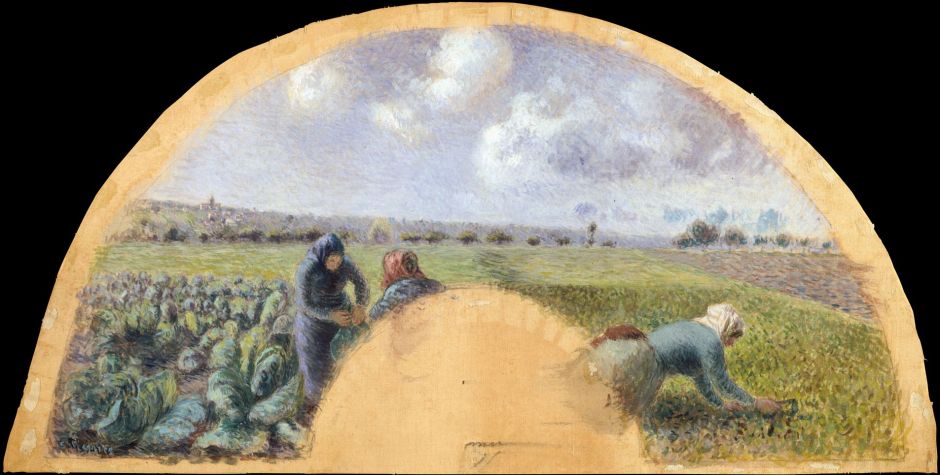This weekend’s pair of articles looks at a form of painting which rose from almost nothing in Europe to being popular among the Impressionists and Post-Impressionists during the 1880s, but which has now largely been forgotten: fine art – rather than purely decorative – painting on fans, something practised by Edgar Degas, Camille Pissarro and, most of all, by Paul Gauguin. Although examples of these beautiful paintings are hard to come by, and good images of them even rarer, I’ll try to tell their story here, and in the sequel tomorrow.
Hand fans, which could be held and wafted to force convective cooling in hot conditions, didn’t appear spontaneously in Europe, but seem to have been brought from the Middle East at the time of the Crusades. Following the Renaissance they became more elaborate, a fashion accessory which could be used for surreptitious communication between lovers when in company.
They have much richer history in East Asia, where they became canvases for fine art painting well before 1600.

This exquisite painting of a View of Kyoto by Kanō Munehide was made on gold paper during the Momoyama period, most probably in the early 1580s.

Wang Shimin’s 王時敏 untitled folding fan was painted in 1677.
Although a very few European artists do seem to have painted the occasional fan, by and large those made in Europe were decorated by illustrators rather than established fine art painters. Many of the fan-makers in France were Huguenot craftsmen, Protestants in a Catholic state who suffered repeated oppression, and most were forced to leave before they gained equal rights with the French Revolution at the end of the eighteenth century.

When trade between Japan and Europe started to re-open in the middle of the nineteenth century, this was a more typical example of the type of decorated fan which appeared in Europe, a Performance Fan with Design of Fans on Water.

When France and most of the rest of Western Europe was swept by enthusiasm for everything Japanese, during the latter half of the nineteenth century, some of the painted fans coming from East Asia were very different, clearly the work of artists like Ren Yi 任頤 (Ren Bonian) whose Scholar on a Rock from about 1880 is quite different.
Several of the French Impressionists were enthusiastic collectors of Japanese art, and their own work fell under the spell of Japonisme. I’ve been unable to discover which of them first explored the potential of the fan as a form of painting, but it seems to have happened in the five years after the First Impressionist Exhibition of 1874.
The two who were early enthusiastic painters of fans were Edgar Degas and Camille Pissarro. At the time, both were broke and desperately seeking means of increasing the meagre income they made from painting. Decorated fans may have seemed a good little earner at a time when the more affluent were looking for novelties, particularly those which could be given discreetly to a mistress.
It appears that it was Degas who encouraged Pissarro to paint fans, in the hope that the Impressionist Exhibition of 1879 would have a whole room devoted to these works. Although that didn’t happen, a few examples of painted fans have survived from this period.

Pissarro’s The Cabbage Gatherers is thought to have been painted between 1878-79, and shows countrywomen harvesting cabbages in the fields near Pontoise. This was most probably shown at the Impressionist Exhibition, although not in its own room as Degas had hoped.
This was bought fairly quickly by one of Pissarro’s first American collectors, Louisine Elder, who was to become Mrs. H. O. Havemeyer, thus a major patron of the arts in general and Impressionism in particular. Thanks to the mediation of Mary Cassatt who acted as Elder’s agent, Pissarro sold his first fan, and it was shipped to his first American collector.

The only painted fan that I can find by Degas is his Dancers on the Stage from about 1879. Whereas Pissarro had worked in gouache on silk, Degas used pastel with ink and wash on paper, which could have been cut out and mounted in the fan mechanism itself.

Over the next decade, Pissarro painted more fans too, including this view of The Railway Bridge at Pontoise from about 1882-83, again using gouache and watercolour on silk. His motif here is reminiscent of Monet’s paintings of a similar bridge at Argenteuil almost a decade earlier.

Pissarro used the same media for his Shepherds in the Fields with a Rainbow from 1885, but then seems to have stopped painting fans.
In tomorrow’s article I’ll take this brief history on into the later 1880s, when they became something of an obsession for Paul Gauguin.

